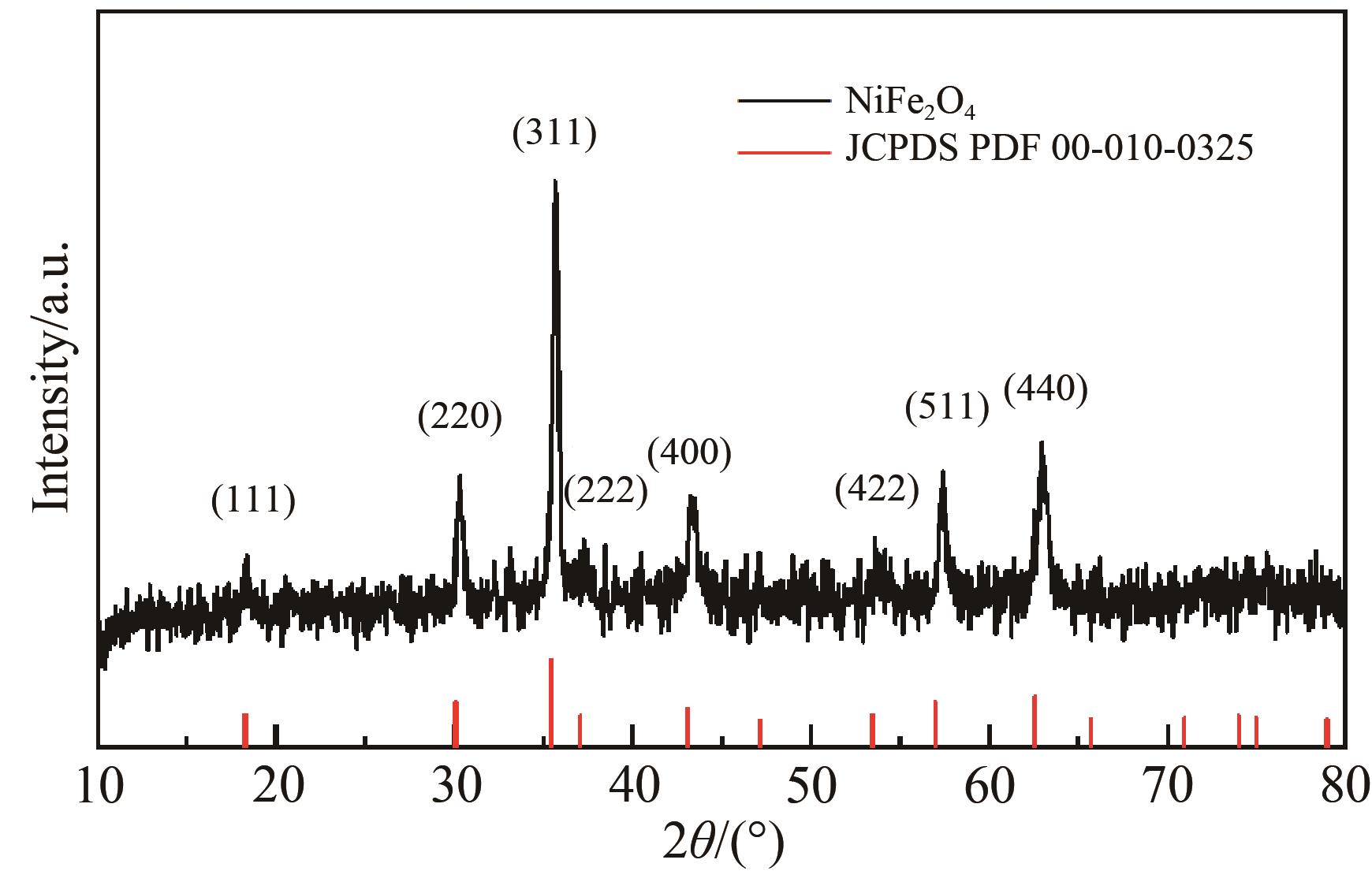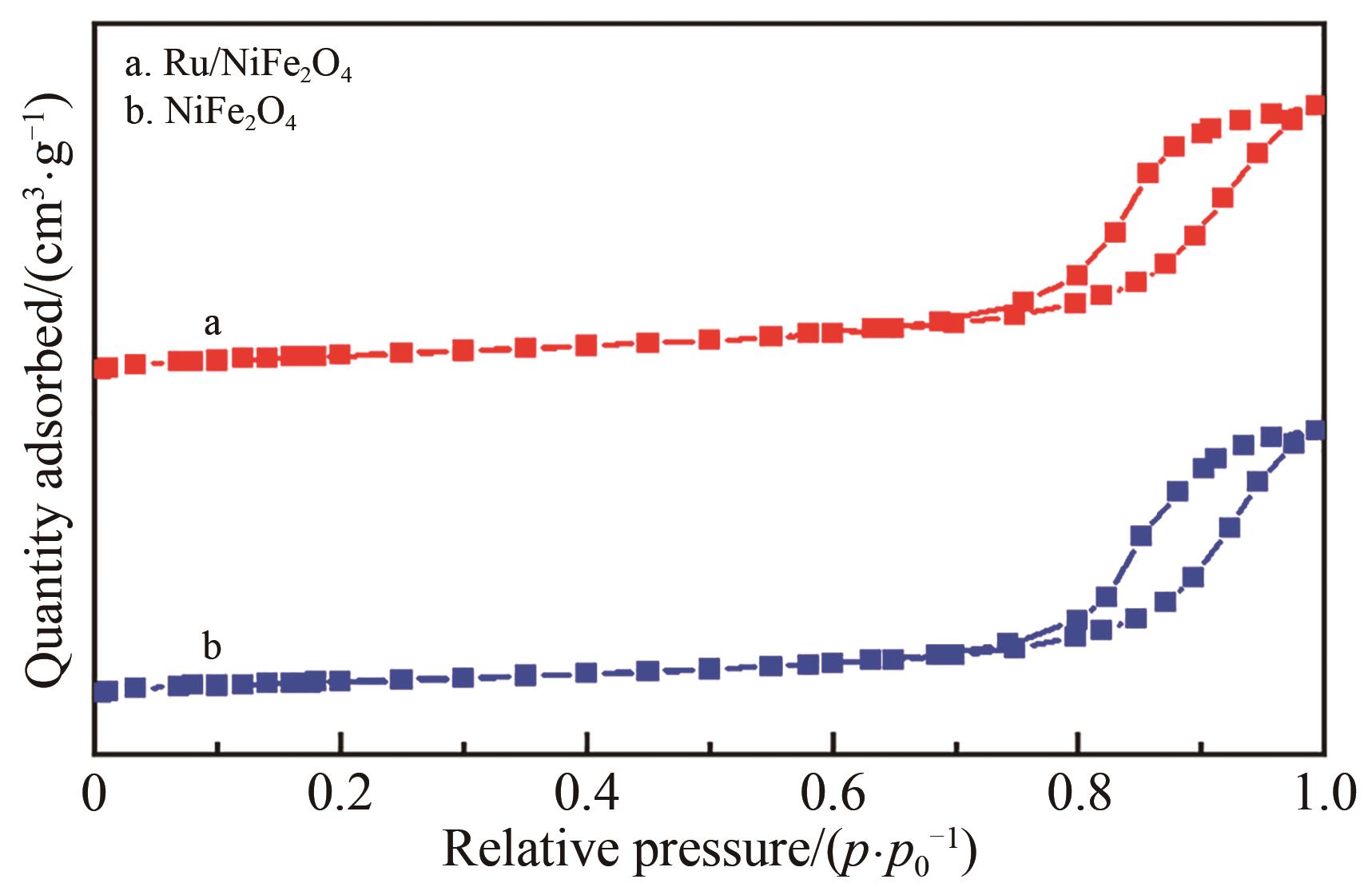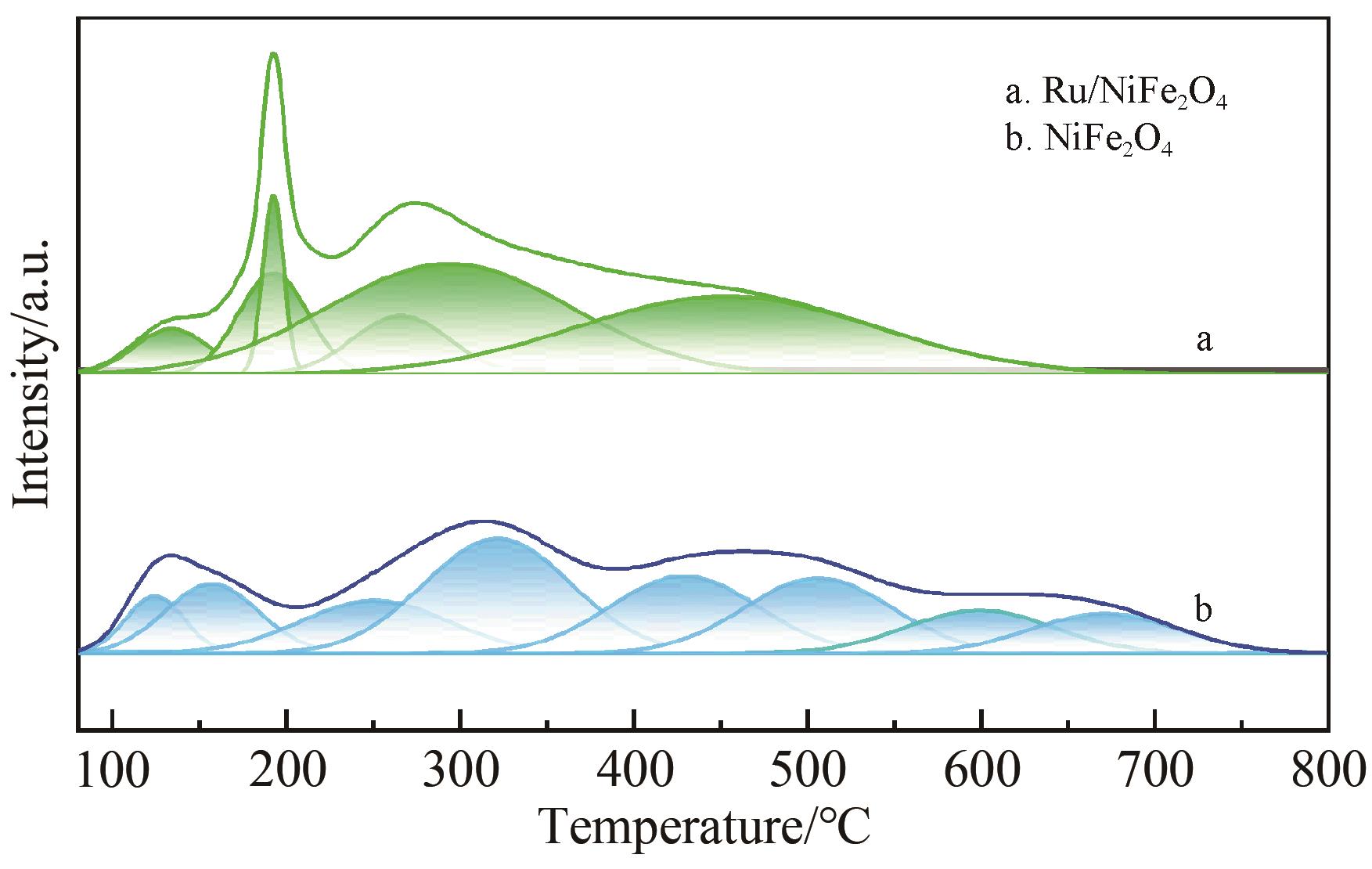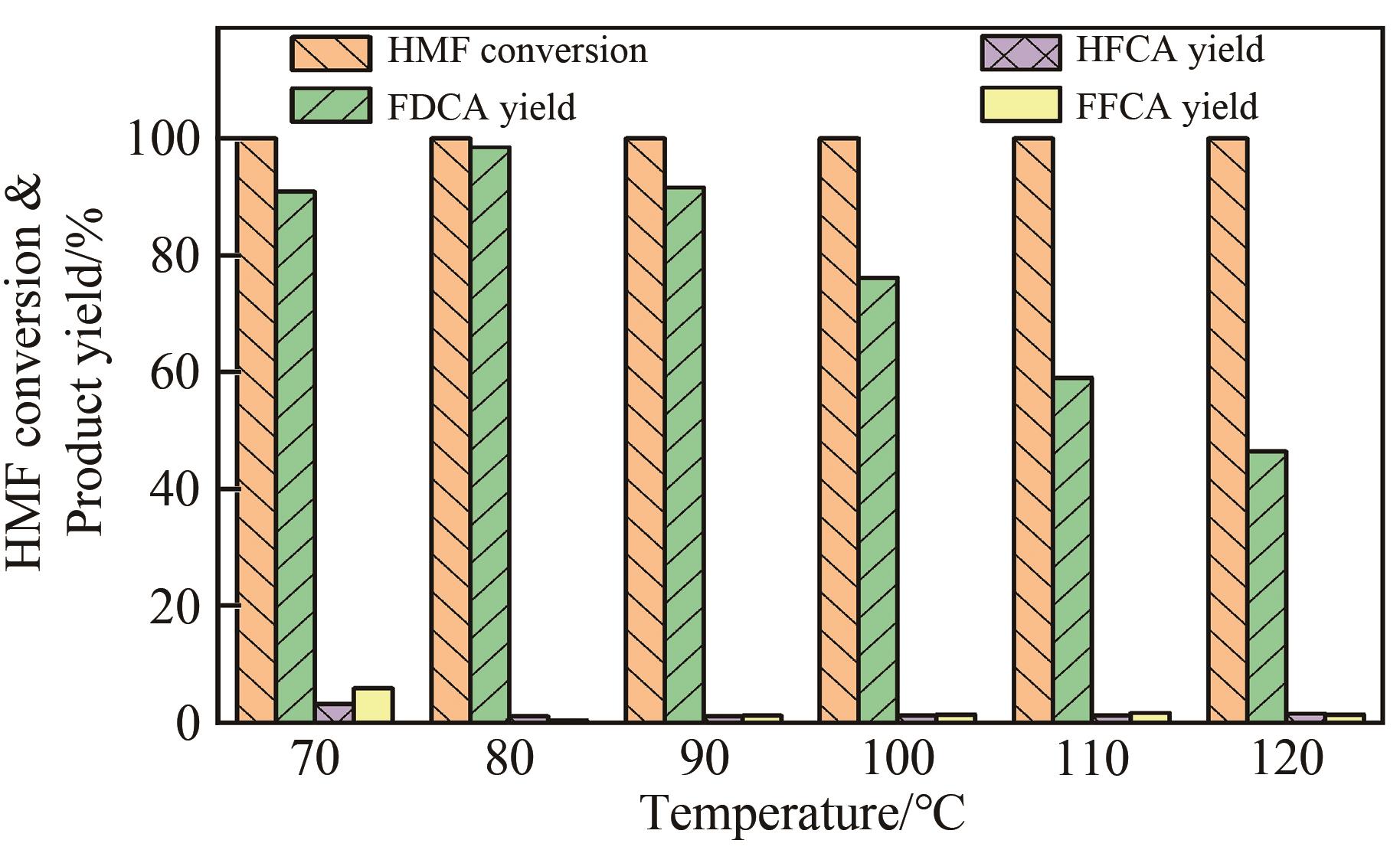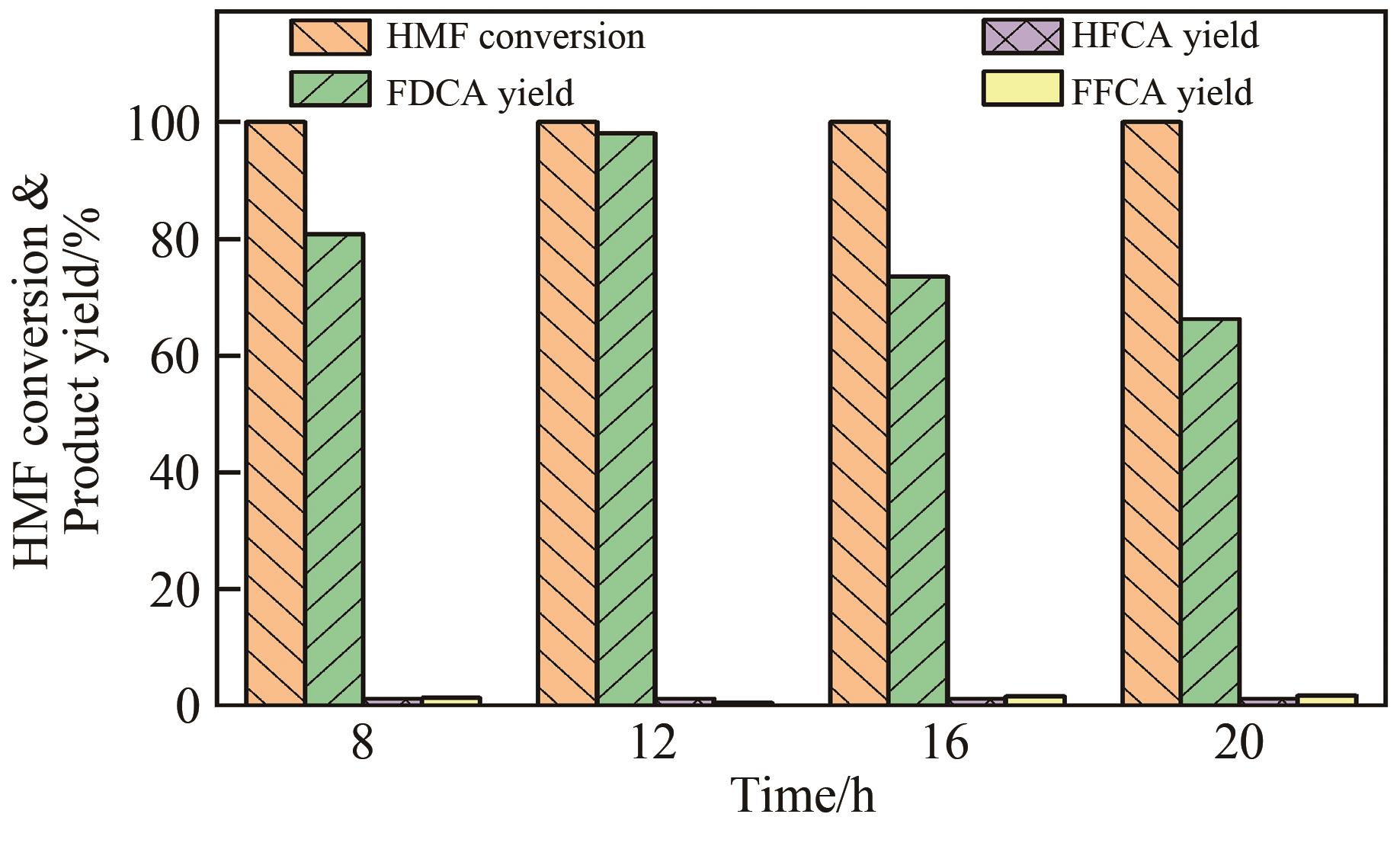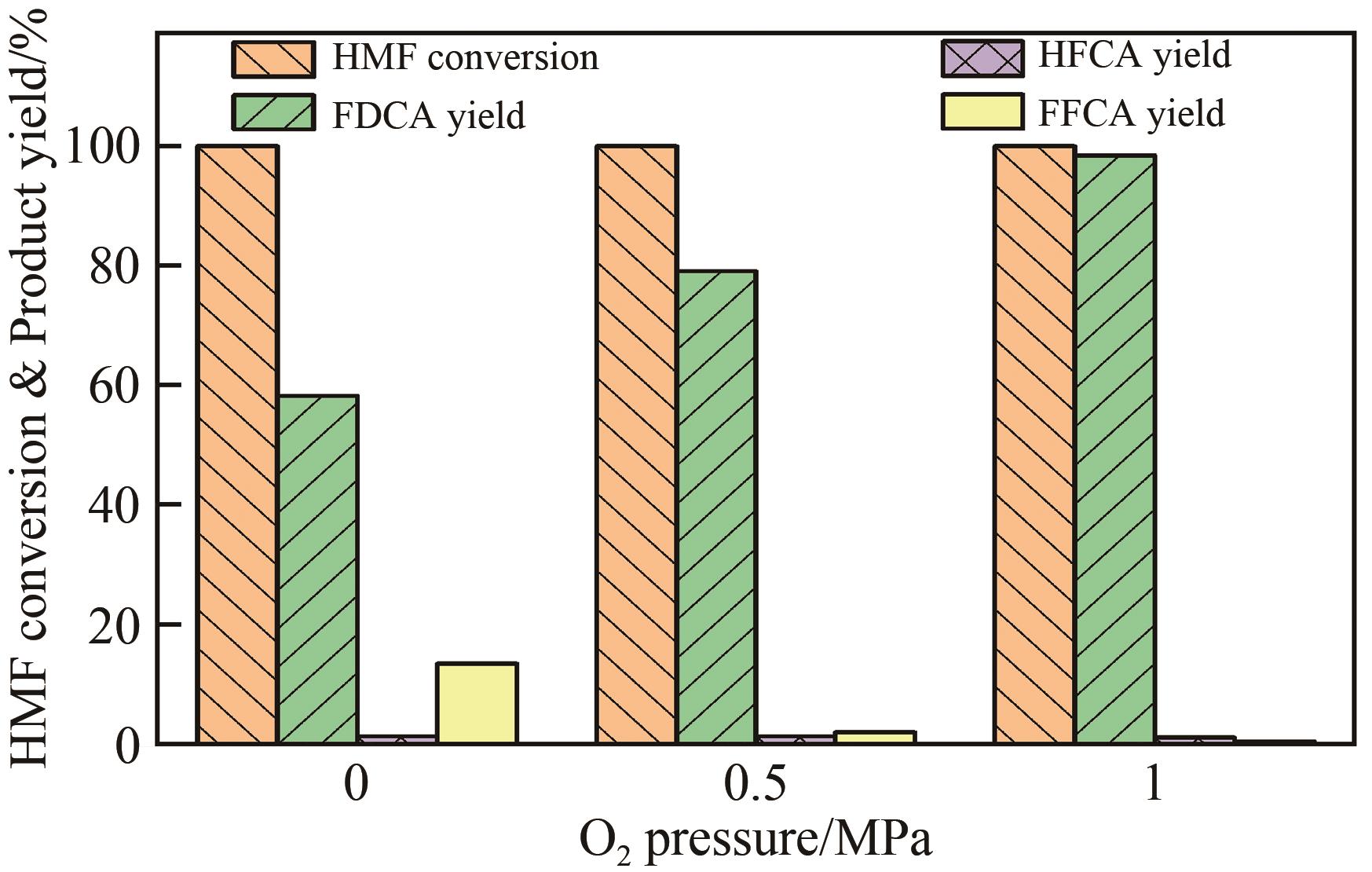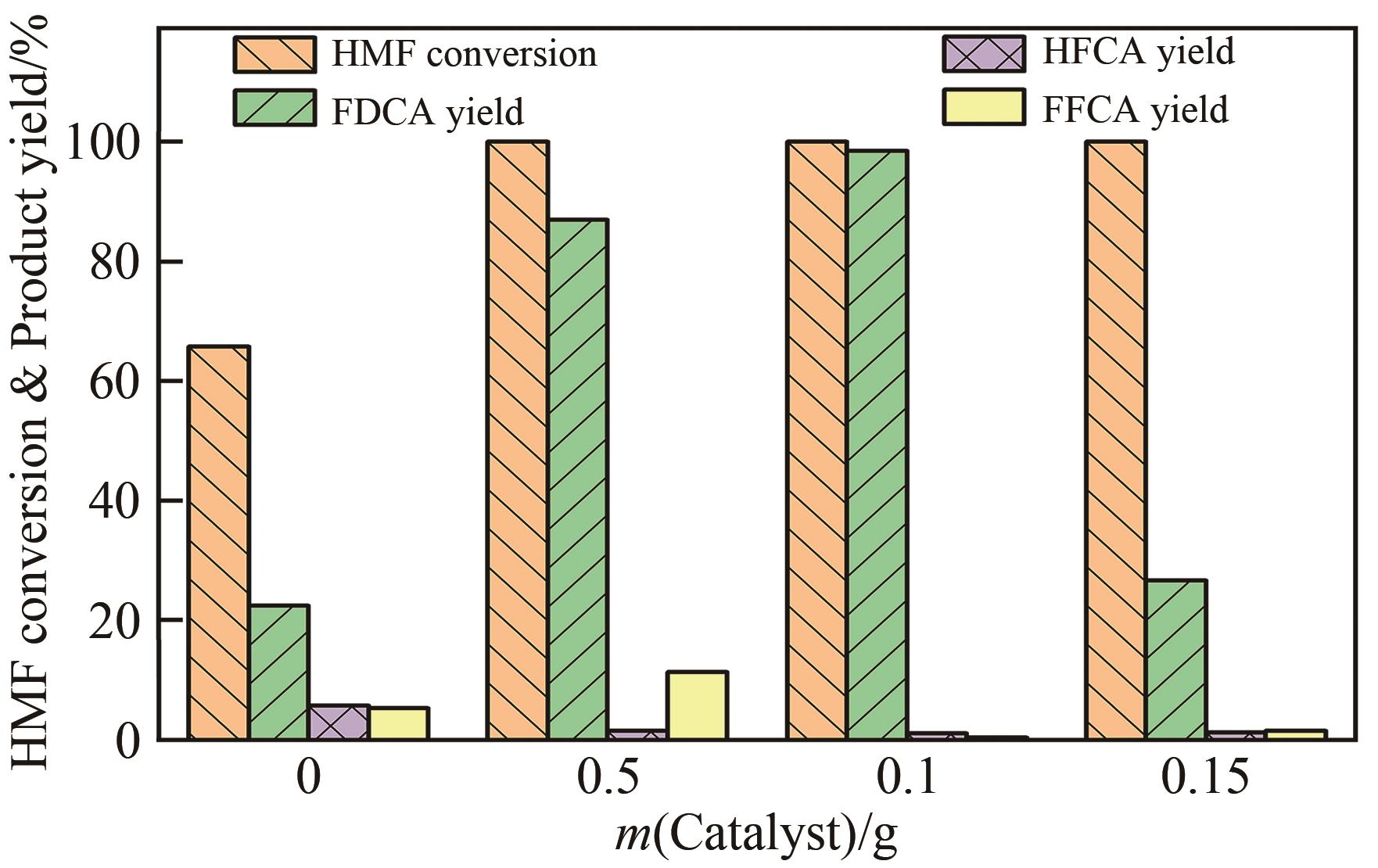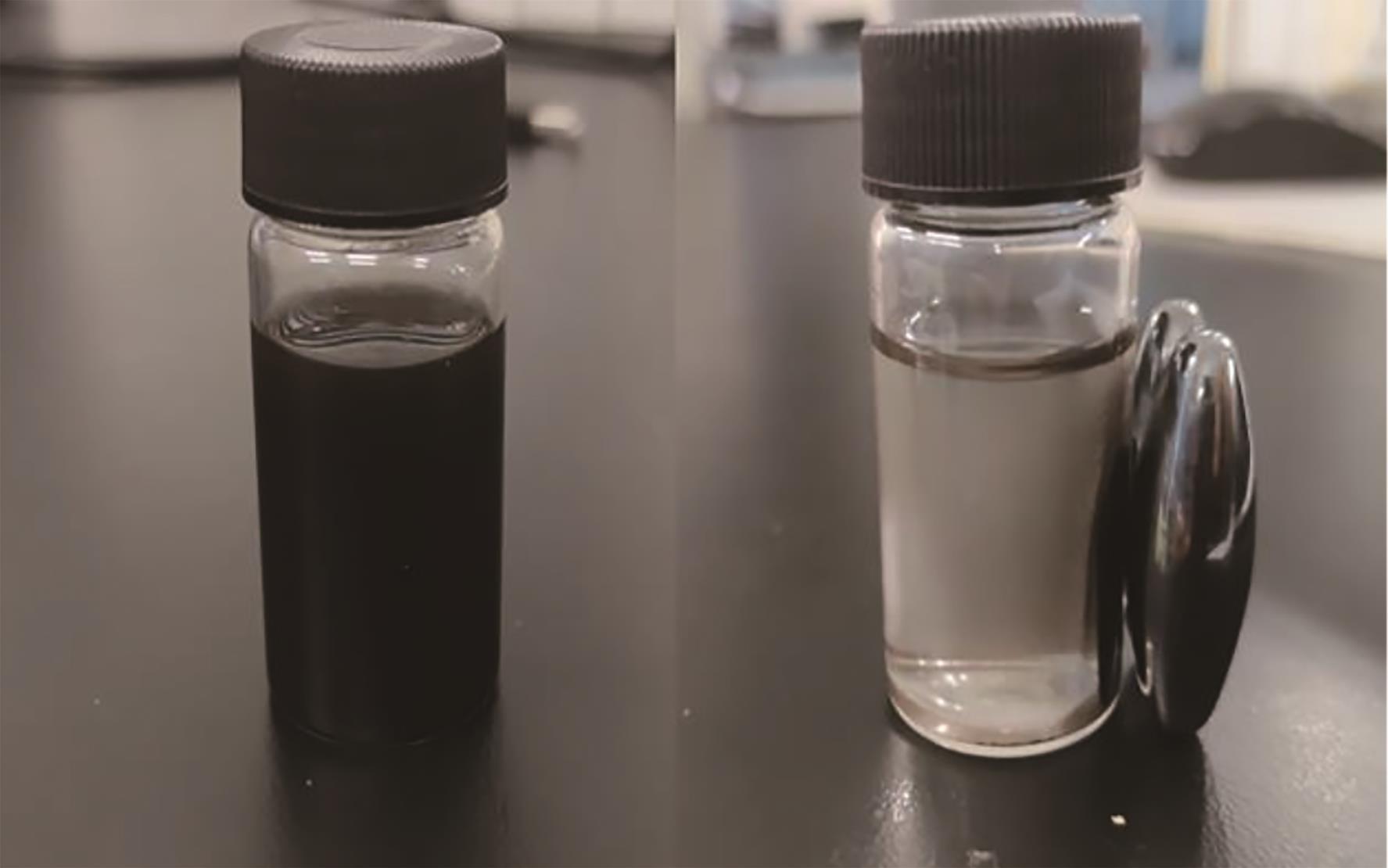
Chinese Journal of Applied Chemistry ›› 2023, Vol. 40 ›› Issue (6): 879-887.DOI: 10.19894/j.issn.1000-0518.220396
• Full Papers • Previous Articles Next Articles
Selective Oxidation of 5-Hydroxymethylfurfural to 2,5-Furandicarboxylic Acid over Ru Supported on Magnetic NiFe2O4
Yu-Wen YANG1, Jing-Yao QI2, Lin LI3, Guo-Ning CHU1, Sai WANG1, Yu ZHANG1, Shuang ZHANG1( )
)
- 1.Institute of Petrochemical Technology,Jilin Institute of Chemical Technology,Jilin 132022,China
1.Jilin Petrochemical Company Organic Synthesis Plant,Jilin 132021,China
3.BASF PJPC Neopentylglycol Company Limited,Jilin 132021,China
-
Received:2022-12-09Accepted:2023-03-27Published:2023-06-01Online:2023-06-27 -
Contact:Shuang ZHANG -
About author:zs3062332@126.com
-
Supported by:the Natural Science Foundation of Jilin Provincial Science and Technology Department(YDZJ202101ZYTS163);Jilin Institute of Chemical Technology Doctoral Launch Fund(2020006);the Science and Technology Research Project of Jilin University of Chemical Technology(202020)
CLC Number:
Cite this article
Yu-Wen YANG, Jing-Yao QI, Lin LI, Guo-Ning CHU, Sai WANG, Yu ZHANG, Shuang ZHANG. Selective Oxidation of 5-Hydroxymethylfurfural to 2,5-Furandicarboxylic Acid over Ru Supported on Magnetic NiFe2O4[J]. Chinese Journal of Applied Chemistry, 2023, 40(6): 879-887.
share this article
Add to citation manager EndNote|Ris|BibTeX
URL: http://yyhx.ciac.jl.cn/EN/10.19894/j.issn.1000-0518.220396
| Catalyst | Acid amount/(mmol·g-1) | Conversion/% | Yield/% | |||||||
|---|---|---|---|---|---|---|---|---|---|---|
| Weak acid | Moderate acid | Strong acid | Total | HMF | FDCA | HFCA | FFCA | |||
| NiFe2O4 | 0.07 | 0.11 | 0.29 | 0.47 | 99.5 | 17.5 | 3.6 | 11.1 | ||
| Ru/NiFe2O4 | 0.25 | 0.36 | 0.31 | 0.92 | 100 | 61.3 | 1.1 | 1.6 | ||
Table 1 NH3-TPD acid amount results and catalytic activity before and after loading
| Catalyst | Acid amount/(mmol·g-1) | Conversion/% | Yield/% | |||||||
|---|---|---|---|---|---|---|---|---|---|---|
| Weak acid | Moderate acid | Strong acid | Total | HMF | FDCA | HFCA | FFCA | |||
| NiFe2O4 | 0.07 | 0.11 | 0.29 | 0.47 | 99.5 | 17.5 | 3.6 | 11.1 | ||
| Ru/NiFe2O4 | 0.25 | 0.36 | 0.31 | 0.92 | 100 | 61.3 | 1.1 | 1.6 | ||
| Element | Run-1 | Run-2 | Run-3 | Run-4 | Run-5 |
|---|---|---|---|---|---|
| Ru | 0.00 | 0.00 | 0.00 | 0.00 | 0.00 |
Table 2 Mass concentration of Ru in the reaction(mg/L)
| Element | Run-1 | Run-2 | Run-3 | Run-4 | Run-5 |
|---|---|---|---|---|---|
| Ru | 0.00 | 0.00 | 0.00 | 0.00 | 0.00 |
| 1 | BEASSON M, GALLEZOT P, PINEL C. Conversion of biomass into chemicals over metal catalysts[J]. Chem Rev, 2014, 114(3): 1827-1870. |
| 2 | XU C, PAONE E, RODRÍGUEZ-PADRÓN D, et al. Recent catalytic routes for the preparation and the upgrading of biomass derived furfural and 5-hydroxymethylfurfural[J]. Chem Soc Rev, 2020, 49(13): 4273-4306. |
| 3 | HAYASHI E, YAMAGUCHI Y, KAMATA K, et al. Effect of MnO2 crystal structure on aerobic oxidation of 5-hydroxymethylfurfural to 2, 5-furandicarboxylic acid[J]. J Am Chem Soc, 2019, 141(2): 890-900. |
| 4 | 陈英, 姜敏, 孙长江, 等. 聚2, 5-呋喃二甲酸乙二醇酯/聚丁二酸丁二醇酯共混物的制备与表征[J]. 应用化学, 2015, 32(9): 1022-1027. |
| CHEN Y, JIANG M, SUN C J, et al. Preparation and characterization of poly(ethylene 2, 5-furandicarboxylate)/poly(butylene succinate) blends[J]. Chin J Appl Chem, 2015, 32(9): 1022-1027. | |
| 5 | ADVANI J H, MORE G S, SRIVASTAVA R. Spinel-based catalysts for the biomass valorisation of platform molecules via oxidative and reductive transformations[J]. Green Chem, 2022, 24(9): 3574-3604. |
| 6 | WAN X, TANG N, XIE Q, et al. A CuMn2O4 spinel oxide as a superior catalyst for the aerobic oxidation of 5-hydroxymethylfurfural toward 2, 5-furandicarboxylic acid in aqueous solvent[J]. Catal Sci Technol, 2021, 11(4): 1497-1509. |
| 7 | ZHANG S, SUN X, ZHENG Z, et al. Nanoscale center-hollowed hexagon MnCo2O4 spinel catalyzed aerobic oxidation of 5-hydroxymethylfurfural to 2,5-furandicarboxylic acid[J]. Catal Commun, 2018, 113: 19-22. |
| 8 | MISHRA D K, LEE H J, KIM J, et al. MnCo2O4 spinel supported ruthenium catalyst for air-oxidation of HMF to FDCA under aqueous phase and base-free conditions[J]. Green Chem, 2017, 19(7): 1619-1623. |
| 9 | GAWADE A B, NAKHATE A V, YADAV G D. Selective synthesis of 2, 5-furandicarboxylic acid by oxidation 5-hydroxymethylfurfural over MnFe2O4 catalyst[J]. Catal Today, 2018, 309: 119-125. |
| 10 | 陈文龙. 碳纳米管负载铂、钌催化剂的制备及其催化羰基化合物加氢性能研究[D]. 兰州: 西北师范大学, 2016. |
| CHEN W L. Preparation and catalytic properties of carbon nanotubes supported platinum and ruthenium catalysts in the hydrogenation of carbonyl compounds[D]. Lanzhou: Northwest Normal University, 2016. | |
| 11 | 刘帅, 黄振, 何方, 等. NiFe2O4为载氧体的生物质半焦化学链燃烧热力学模拟研究[J]. 新能源进展, 2016, 4(3): 172-178. |
| LIU S, HUANG Z, HE F, et al. Thermodynamic simulation of chemical chain combustion of biomass char with NiFe2O4 as oxygen carrier[J]. Adv New Renew Energy, 2016, 4(3): 172-178. | |
| 12 | 陈康伟, 熊文婷, 符继乐, 等. 合成气费托合成制重质烃Ru-Co/SiC催化剂的制备及性能[J]. 化工学报, 2021, 72(7): 3648-3657. |
| CHEN K W, XIONG W T, FU J L, et al. Preparation and performance of Ru-Co/SiC catalyst for Fischer-Tropsch synthesis of syngas to heavy hydrocarbons[J]. CIESC J, 2021, 72(7): 3648-3657. | |
| 13 | 孙景玉. 直接甲醇燃料电池碳纳米管负载的阳极催化剂研究[D]. 乌鲁木齐: 新疆大学, 2007. |
| SUN J Y. Studies on anode catalysts supported on carbon nanotubes for direct methanol fuel Cell[D]. Urumqi: Xinjiang University, 2007. | |
| 14 | SEEKHIAW P, PINTHONG P, PRASERTHDAM P, et al. Optimal conditions for butanol production from ethanol over MgAlO catalyst derived from Mg-Al layer double hydroxides[J]. J Oleo Sci, 2022, 71(1): 141-149. |
| 15 | LIU M, ZHANG J, LIU J, et al. Synthesis of PVP-stabilized Pt/Ru colloidal nanoparticles by ethanol reduction and their catalytic properties for selective hydrogenation of ortho-chloronitrobenzene[J]. J Catal, 2011, 278(1): 1-7. |
| 16 | YANG Y J, FENG Z, LI X, et al. One step synthesis of 2, 5-furandicarboxylic acid from fructose catalyzed by Ce modified Ru/HAP[J]. J Fuel Chem Technol, 2020, 48(8): 942-948. |
| 17 | BENRABAA R, BOUKHLOUF H, LÖFBERG A, et al. Nickel ferrite spinel as catalyst precursor in the dry reforming of methane: synthesis, characterization and catalytic properties[J]. J Nat Gas Chem, 2012, 21(5): 595-604. |
| 18 | 张丹, 尚润梅, 赵振涛, 等. V/Ce-Al2O3催化甲醇选择性氧化制备二甲氧基甲烷[J]. 应用化学, 2022, 39(9): 1429-1436. |
| ZHANG D, SHANG R M, ZHAO Z T, et al. Selective oxidation of methanol to dimethoxymethane over V/Ce-Al2O3[J]. Chin J Appl Chem, 2022, 39(9): 1429-1436. | |
| 19 | DAS S, THAKUR S, BAG A, et al. Support interaction of Ni nanocluster based catalysts applied in CO2 reforming[J]. J Catal, 2015, 330: 46-60. |
| 20 | REDDY G K,BOOLCHAND P,SMIRNIOTIS P G. Unexpected behavior of copper in modified ferrites during high temperature WGS reaction aspects of Fe3+↔Fe2+ redox chemistry from mössbauer and XPS studies[J]. J Phys Chem C, 2012, 116(20): 11019-11031. |
| 21 | GAO T, YIN Y, ZHU G, et al. Co3O4 NPs decorated Mn-Co-O solid solution as highly selective catalyst for aerobic base-free oxidation of 5-HMF to 2, 5-FDCA in water[J]. Catal Today, 2020, 355: 252-262. |
| 22 | GAO T, YIN Y, FANG W, et al. Highly dispersed ruthenium nanoparticles on hydroxyapatite as selective and reusable catalyst for aerobic oxidation of 5-hydroxymethylfurfural to 2,5-furandicarboxylic acid under base-free conditions[J]. Mol Catal, 2018, 450: 55-64. |
| 23 | ZHU M M, DU X L, ZHAO Y, et al. Ring-opening transformation of 5-hydroxymethylfurfural using a golden single-atomic-site palladium catalyst[J]. ACS Catal, 2019, 9(7): 6212-6222. |
| 24 | VANDARKUZHALI S A A, KARTHIKEYAN G, PACHAMUTHU M P. Efficient oxidation of 5-hydroxymethylfurfural to 2, 5-furandicarboxylic acid over FeNPs@NH2-SBA-15 catalyst in water[J]. Mol Catal, 2021, 16: 111951. |
| 25 | KANDASAMY P, GOGOI P, VENUGOPALAN A T, et al. A highly efficient and reusable Ru-NaY catalyst for the base free oxidation of 5-hydroxymethylfurfural to 2,5-furandicarboxylic acid[J]. Catal Today, 2021, 375: 145-154. |
| [1] | Ning YUAN, Jie MA, Jin-Ling ZHANG, Jian-Sheng ZHANG. Preparation of PCN-6(M) Bimetallic Organic Framework Materials by Steam-assisted Method and Their CO2 and CH4 Adsorption Performance [J]. Chinese Journal of Applied Chemistry, 2023, 40(6): 896-903. |
| [2] | Hai-Xiang XIU, Wan-Qiang LIU, Dong-Ming YIN, Yong CHENG, Chun-Li WANG, Li-Min WANG. Research Progress of AB2 Laves Phase Hydrogen Storage Alloys [J]. Chinese Journal of Applied Chemistry, 2023, 40(5): 640-652. |
| [3] | Lin YANG, Hui PAN, Ding-Feng GAO, Xiao-Dong WANG. Preparation and Characterization of Nanocomposite Leather Finishing Agent Based on Aramid Modified Polymer [J]. Chinese Journal of Applied Chemistry, 2023, 40(5): 708-719. |
| [4] | Yu FANG, Wang-Qiang KUANG, Sheng-Ting KUANG, Wu-Ping LIAO. Selective Extraction and Recovery of Copper from the Leaching of Low-grade Copper Ore by H2SO4-NaCl Solution Using Cextrant 230 [J]. Chinese Journal of Applied Chemistry, 2023, 40(5): 758-768. |
| [5] | Mou-Cui LI, Yang-Ming DONG, Ying-Hui REN, Hai-Xia MA, Le QI. Synthesis, Antifungal Activity and Molecular Docking Study of 1,2,4-Triazole Bis-Schiff Base Derivatives [J]. Chinese Journal of Applied Chemistry, 2023, 40(1): 116-125. |
| [6] | Yan-Qin CHENG, Zhuo-Xi LI, You-Di WANG, Juan-Juan XU, Zheng BIAN. Structurally Simplified 4-Hydroxyprolinamide for Highly Efficient Asymmetric Michael Addition of Aldehydes to Nitroolefins [J]. Chinese Journal of Applied Chemistry, 2023, 40(1): 146-154. |
| [7] | Jia-Xin GUO, Yang LIU, Chang-Shan XU, Xiao-Nan LIU, Liang CHENG. The Changes of Mg2+ Mass Concentration in MgO NPs Suspension and Its Effects on the Growth of Wheat (Triticum aestivum L.) under Different pH [J]. Chinese Journal of Applied Chemistry, 2022, 39(9): 1401-1411. |
| [8] | En-Tong WANG, Lin-Fang YANG. Preparation and Properties of LiNi0.6Co0.2Mn0.2O2 Cathode Material for High Specific Capacity Lithium Ion Battery [J]. Chinese Journal of Applied Chemistry, 2022, 39(8): 1209-1215. |
| [9] | Bing WANG, Min TANG, Ying WANG, Zhi-Guang LIU. Preparation of Y2O3⁃Dopped SiC Ceramics by Micro⁃oxidation Sintering and Removal of Cd2+ in Mimic Wastewater [J]. Chinese Journal of Applied Chemistry, 2022, 39(8): 1312-1318. |
| [10] | Xiao-Li ZHANG, Yu-Mei PENG, Qing-Wei WANG, Li-Xia QIN, Xiao-Xia LIU, Shi-Zhao KANG, Xiang-Qing LI. Construction of Nano Ag Modified TiO2 Nanotube Array Substrate for Surface Enhanced Raman Scattering Detection and Degradation of Tetracycline Hydrochloride [J]. Chinese Journal of Applied Chemistry, 2022, 39(7): 1147-1156. |
| [11] | Chao ZHANG. Research Prospect of Single Atom Catalysts Towards Electrocatalytic Reduction of Carbon Dioxide [J]. Chinese Journal of Applied Chemistry, 2022, 39(6): 871-887. |
| [12] | Qin YANG, Ning-Hua CHEN, Yu-Jie ZHANG, Zhi-Xiang YE, Ying-Chun YANG. Preparation of Cerium Zirconium Composite Oxide Modified Glassy Carbon Electrode and the Detection of Pb2+ in Water Samples [J]. Chinese Journal of Applied Chemistry, 2022, 39(6): 990-999. |
| [13] | Fu-Yang WANG, Wei-Ming SONG, Li SUN, Jian FENG, Jun YE, Zhi-Qi YANG. Controllable Construction of Porous Nanocube FeSe2/Graphene Composite for Efficient Na⁃Ion Storage [J]. Chinese Journal of Applied Chemistry, 2022, 39(5): 779-786. |
| [14] | Jia-He WANG, Da-Yong LIU, Wei LIU, Lin WANG, Biao DONG. Research Progress on Photocatalytic Antibacterial Application of TiO2 Nano Materials [J]. Chinese Journal of Applied Chemistry, 2022, 39(4): 629-646. |
| [15] | Hong-Zhen PENG, Yu ZHANG, Lin-Jie GUO, Wei SONG, Qing-Nuan LI, Xiang-Ying MENG. Facile One⁃Step Synthesis of WS2@Au Quantum Dot Composite by in situ Reduction and Its Sensing Application [J]. Chinese Journal of Applied Chemistry, 2022, 39(3): 480-488. |
| Viewed | ||||||
|
Full text |
|
|||||
|
Abstract |
|
|||||
